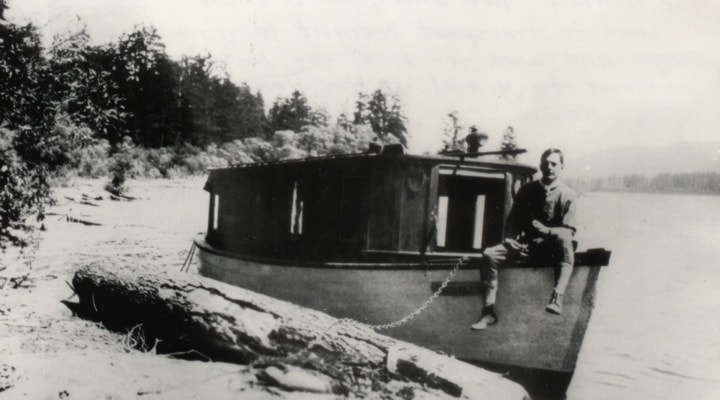In the centre of Lake Cowichan in a rather obscure location along the riverbank lies tiny Gillespie Park. It was named for early pioneer Ken Gillespie who once owned much of what was to become the center of town. Though small, the park attracts the odd fisherman, a few tubers as well as an occasional picnicker and those who just stop to sit and watch the river meander by.
Located beside the Bargain! Shop store (formerly the Lake Cowichan Co-op grocery store) on South Shore Road, the park is a reminder of a man who was once described as “a widely known and colourful resident of the community.”
In 1980 a rock memorial cairn — situated just a few feet from where Gillespie’s house and boathouse once stood — was dedicated to the man who knew the river like no other. A plaque on the cairn says simply: To honour the memory of pioneer resident, G.K. (Ken) Gillespie, 1881 – 1972.
Born in 1881, he first visited the Lake at age nine with his parents, spending two weeks fishing and hunting. He returned once again in 1906 — remaining here until his death at age 91. Ken and a business partner later purchased 160 acres on the river, including the Riverside Hotel. After the partnership broke up, Gillespie retained the hotel and the property encompassing today’s Bargain! Shop.
He raised three sons and a daughter in the nine-room family home he and his wife built in 1912. After the house burnt down in 1945, Gillespie built a small cabin on his property near the riverbank where he lived out his days.
In January 1972, not long before Gillespie died, two old friends — both of them children of early pioneers — visited Gillespie at his cabin. It seems that Gillespie had expressed a willingness to talk about old times with his two friends. It had been years since the men had visited and found, upon entering the place, that they were “instantly transported into a bygone age.” They later recalled that there was no wall-to-wall carpets here, no florescent lighting, refrigeration nor furnace heat; just a tiny room messy and littered, the dingy walls plastered with scores of ancient Christmas cards, postcards, faded photos, and clippings from magazines and newspapers. Water gargled endlessly as it dripped from the tap over a small sink in one corner of the room. A huge woodstove stained and splattered from years of grease dominated the other area where wood was heaped and piled to dry.
Although Ken was 91 at the time, his friends noted that he was remarkably active in mind and body. Even though he talked endlessly, his conversation was informative, interesting and often humorous. During the visit, Ken served Scotch whiskey with lemonade chasers while passing around a box of chocolates.
“At one point, a rat lurked about in the background and now and then, could be heard rummaging near the sink or in the woodpile.”
Ken affectedly answered the questions (about the good old days) fired at him by the two men but it was next to impossible for the men to jot down all he told them and, according to one of the men, Ken had such a fund (of information) from which to draw from, that he was impossible to keep up with.
At the end of the visit, the three friends made plans to visit again, only next time, a tape recorder would be used.
John Saywell, author of Kaatza: The Chronicles of Cowichan Lake summed up the legacy that Ken Gillespie left with the words, “Some people dominate their environment, others let it dominate them, a few so blend into it that they become a landmark, as suited to it as the mountains and the streams. He is symbolic, a composite of all that makes the Lake” (written by John F. T. Saywell when Gillespie was aged 85).
